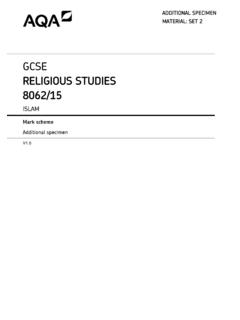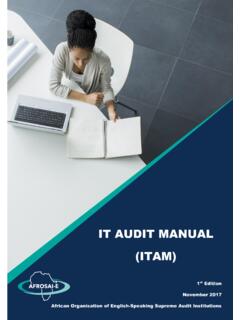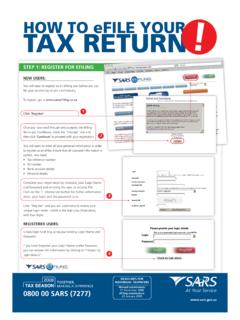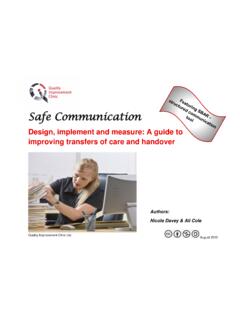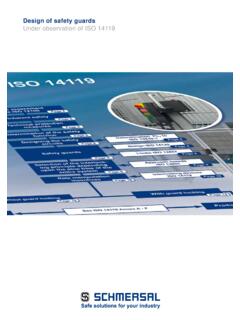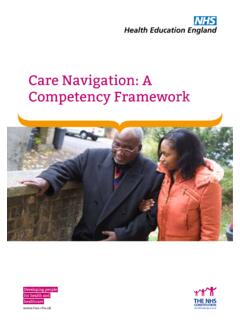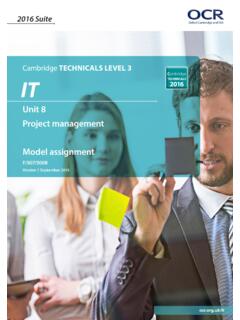Transcription of Cambridge TECHNICALS LEVEL 3 IT
1 2016 Suite Cambridge TECHNICALS LEVEL 3. IT. Unit 4. Computer networks Model assignment H/507/5003. Version 2 May 2017. Contents Guidance for tutors on using this assignment .. 3. General .. 3. Before using this assignment to carry out assessment .. 3. When completing the assignment .. 4. Resources to complete the tasks .. 4. Time .. 4. Format of 4. 5. Group 5. After completing the assignment .. 5. Reworking the assignment .. 5. Modifying the model assignment .. 6. General information for learners .. 7. Assignment for 9. Scenario .. 9. The 11. Task 1 : Plan a computer network for a client .. 11. Task 2 : Communicating the networking solution .. 13. Task 3 : Maintaining the network .. 14. Evidence Checklist .. 15. Please note: You can use this assignment to provide evidence for summative assessment, which is when the learner has completed their learning for this unit and is ready to be assessed against the grading criteria.
2 You can use this assignment as it is, or you can modify it or write your own; we give more information in this document under Guidance for tutors. ALL THESE MATERIALS MAY BE PHOTOCOPIED. Any photocopying will be done under the terms of the Copyright Designs and Patents Act 1988 solely for the purposes of assessment. OCR 2017 2 Model Assignment Version 2. Unit 4: Computer networks Guidance for tutors on using this assignment General OCR Cambridge Technical model assignments are available to download from our website: The purpose of this assignment is to provide a scenario and set of tasks that are typical of how a network analyst would use computer networking knowledge, to enable you to assess your learner against the requirements specified in the grading criteria.
3 The scenario and its tasks are intended to give a work-relevant reason for applying the skills, knowledge and understanding needed to achieve the unit. This assignment will not instruct learners how to meet the highest grade. Whether learners achieve a pass, merit or distinction will depend on what evidence they produce. You can modify the scenario we provide in this assignment to make it more relevant to your local or regional needs. Please refer to the information under Modifying the model assignment' later in this section. You don't have to use this assignment. You can use it as a guide to help you to design your own assignment, and we provide an assignment checking service. You'll find more information on these matters in section 8 of the qualification handbook.
4 In the tasks, we'll refer to the format of evidence. Learners are not required to follow that format unless we tell them otherwise. It's essential that the work every learner produces is their own. Please make sure you read through the information we give on authenticity in section 8 of the qualification handbook and make sure that your learners and any staff involved in assessment understand how important authenticity is. We provide this assignment to be used for summative assessment. You must not use it for practice or for formative assessment. Before using this assignment to carry out assessment Learners will need to take part in a planned learning programme that covers the knowledge, understanding and skills of the unit. When your learners are ready to be assessed, they must be provided with a copy of the following sections of this assignment: General information for learners Assignment for learners Evidence Checklist They may carry out preparation prior to undertaking the tasks and there is no time limit for this.
5 OCR 2017 3 Model Assignment Version 2. Unit 4: Computer networks When completing the assignment You should use this assignment in conjunction with the unit specification and qualification handbook. Learners must be allowed sufficient time to complete all of the tasks. The amount of time may vary depending on the nature of the tasks and the ability of individual learners. To help with your planning against each of the tasks we have given an indication of how long it should take. Learners can produce evidence in several sessions. Resources to complete the tasks There are no specific resources that you need to make available to learners when they are taking this assignment. You'll need to give them a copy of the scenario and the tasks. Time You should plan for learners to have 5 8 hours to complete this assignment.
6 Learners must be allowed sufficient time to complete all the tasks. The amount of time may vary depending on the nature of the tasks and the ability of individual learners. To help with your planning, against each of the tasks we've given an indication of how long it should take. Learners can produce evidence in several sessions. Format of evidence Learners have to produce evidence that demonstrates how they have met the grading criteria. At the very least they must produce evidence that meets all of the pass criteria. Please make sure your learners realise that missing just one pass criterion means they will not pass the unit, even if they have successfully met the merit and distinction criteria. We have said what format the evidence could take for each task.
7 Learners are not required to follow the format we have given unless we have told them otherwise. For example, if we say You could include a report on ' the evidence does not have to follow any specific reporting conventions. You can modify the format of the evidence but you must make sure the format allows the learner to access all of the grading criteria. If we require that evidence must take a specific format, we will make that clear in the task for learners. If we have not specified a format for evidence learners are free to use the format that they feel is most appropriate for the purpose and target audience for each individual task. For more guidance on generation and collection of evidence, please refer to the section 8 Internal Assessment', in the qualification handbook.
8 OCR 2017 4 Model Assignment Version 2. Unit 4: Computer networks Authenticity Authenticity in assessment is about making sure the work the learner produces for assessment is their own. We give information on authenticity in the qualification handbook under section 8. You must read through this and make sure all staff involved in assessment and your learners understand how important authenticity is. Group work This assignment has not been written to include group work. If you plan to ask learners to work in a team to complete work for assessment, you need to determine at which point in an assessment task learners can work together. After completing the assignment Once the learner has submitted their work to you to be assessed, you must judge or mark' the work against the grading criteria for the unit and identify one grade for the unit.
9 For further information about assessment, please refer to section 8 of the qualification handbook. Your assessment decisions must be quality assured across the cohort of learners in your centre who are being entered for the same unit. This must be done through an internal standardisation process . We give information on internal assessment and standardisation in the qualification handbook. Reworking the assignment If you and the learner feel they've not performed at their best during the assessment, the learner can, at your discretion, improve their work and resubmit it to you for assessment. If a learner is working on improving their work before it is resubmitted, you and the learner must continue to make sure the work is the learner's own. Any feedback you give to the learner must not direct them on how to improve their work.
10 You can identify what area of the work could be improved but you cannot give the learner any details about how they could improve it. You must follow the guidelines given in section 8 of the qualification handbook under Authenticity of learner work'. OCR 2017 5 Model Assignment Version 2. Unit 4: Computer networks Modifying the model assignment The tasks in this assignment allow learners access to the full range of grades detailed in the grading criteria of this unit. If you modify this assignment you must not change the grading criteria provided in the tasks for the learner or in the evidence checklist. These grading criteria are taken from the unit. You can modify the scenario to suit your local or regional needs and the tasks may be contextualised to match any changes you have made to the scenario.










